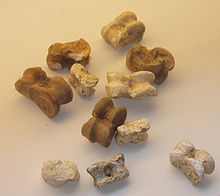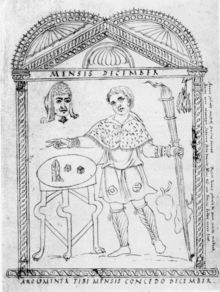Astragaloi
Astragaloi is the Greek name for various games of skill and dice . In ancient times, the jumping legs from the hind legs of cloven-hoofed animals such as sheep, goats or cattle were used as game pieces or dice . The Greeks called these bones ἀστράγαλοι astrágaloi ( singular astrágalos ), the Romans called them tali (singular talus ). In German, the designation of the play bone is astragalus , astragalus or Latinized Astragalus (in the plural Astragale or Astragaloi or Astragali).
Astragalas are still played in rural areas of Greece and Turkey, as well as in the Islamic countries of the Middle East and Central Asia , but also in France. There are skill, movement and guessing games, dice games and mixed forms.
Games of skill

Roman copy (2nd century) based on a Greek original from the Hellenistic period, Staatliche Museen zu Berlin
The Greek philosopher Plato (428–349 BC) mentions in one of his dialogues some games of skill that boys used to play with astragalus in the gymnasium .
In Artiasmos or Latin par - impar ("even - odd"), a kind of puzzle game for two, you had to guess whether the number of astragales that the other player had previously covered in his hand is even or odd.
For a game called Omilla , a circle was drawn on the floor into which the astragals had to be thrown. The aim was to shoot the ankles of the teammates already in it out of the circle. This game is still widespread today in Turkey and the Middle East, so that one at least knows more about the current rules of the game. After that, the diameter of the circle, in the center of which the players each place an astragalus on one narrow side at the beginning of the game, is at least 1 meter. The starting point is determined in that a teammate from the circle tries to shoot the first player's throwing ragal, which is lying some distance away, with a targeted hit even further away. In the game, the location for throwing is the place where the thrown ankle of the previous player stopped. Whoever manages to shoot an ankle out of the circle is allowed to keep it.
Tropa was the name of a game in which an ankle had to be thrown into a small hole in the ground from a certain distance.
The best known and most widespread astragalus game is the five stone game, which the Greeks called pentelitha (Greek pente "five", lithos "stone") and is still played today, e.g. B. in Turkey as beṣtaṣ (Turkish beṣ "five", taṣ "stone"). In England, where it is played with so-called jacks , it is called fivestones or fivebones . The names show that the game can also be played with stones or other small objects. According to Iulius Pollux (2nd century), this game was about catching the astragals thrown into the air on the back of the hand. Those who had fallen had to be picked up without those lying on the back of their hands falling down. The five stone game was mainly played by girls in ancient times. A marble painting found in the city of Herculaneum , buried by the eruption of Vesuvius in 79 , shows five goddesses, the two of whom play Pentelitha in the foreground.
The five stone game has survived for more than two millennia. In a variant that is still widespread in Turkey today, the knuckles (or stones) on the back of the hand must be thrown into the air and caught with the same hand. It is not known whether the game popular nowadays, in which an astragalus is thrown into the air, a lying on the ground has to be picked up with the same hand and the thrown one has to be caught again, is not known in ancient times.
Dice games
The astragalus is also suitable for dicing. It has a characteristic shape with four easily distinguishable sides: a strongly arched broad side ( called "belly" by Aristotle ), a broad side with a deep cavity (called "back" by Aristotle), a relatively flat narrow side and an S-shaped fluted narrow side with a beak-like pointed process. When throwing the astragalus always remains on one of these four sides. The astragalus does not rest on the curved underside or the upper side with the horn-like appendages without leaning against it. The difference to the six-sided cubic cube consists on the one hand in the number of sides (4 instead of 6) and on the other hand in the unequal frequency with which it stays on a certain side. When you roll the dice with these knuckles, you can easily see that the astragalus remains on one of the two broad sides in 8 out of 10 cases. Only in 10% of the attempts does it fall on one of the narrow sides called Kos (dog or vulture) and Chios by the Greeks, and least of all on the S-shaped fluted Kos side. The Greeks assigned the numerical values to the sides in such a way that the opposite sides resulted in the sum 7, as with the six-sided dice: the rare narrow sides counted 1 (Kos) and 6 (Chios), the broad sides 3 (back) and 4 (belly); 2 and 5 do not occur.
In ancient times, children seem to have thrown two astragals, which could also be thrown individually one after the other. The adult Greeks of antiquity usually threw four astragals, with which 35 different throw combinations with 19 different values can be achieved. Some litters were named after gods, heroes, kings or other famous people. Some of these names have been handed down. In a grave poem written as a riddle ( Anthologia Graeca , VII 427) combinations are referred to as Alexander and Ephebe . However, it is not known which eye combinations were so called and how much they counted. A litter called Stesichoros was worth 8 points. The Euripides scored 40 points, much more than the highest possible number of 24 points with four sixes. Only the highest litter was named after a deity and was named Venus after the goddess of love , which was the case when "none of the four ankles shows you the same face", i.e. each of the four astragals remained on a different side and the result was 1,3,4,6. However, the evaluation system seems to have been complicated and not generally applicable, as Ovid shows. The Venus litter played a special role in a rule apparently invented by Emperor Augustus himself. Each player rolls four astragals. For every 1 or 6 a denarius had to be paid into a common treasury, which was won by whoever scored the throw of Venus.
Sanctions against the game of dice
The game was mainly for money. Sometimes the stakes were so high that game losses led to ruin. Probably for this reason there were early attempts to legally prohibit the game of dice. Plautus already speaks of a “dice law” ( lex aleatoria ). The laws do not seem to have been particularly effective, for it was played in all classes, from the poor, who played for ring and cloak, to the emperors. Claudius in particular was known as a passionate player. He not only wrote a book about the game of dice, but also had a traveling car converted so that the built-in game board was only slightly shaken during the journey.
The ban on the game of dice was only officially lifted once a year, namely on the festival of Saturnalia , which is celebrated in December . As Seneca notes, there was "everywhere the unstable September from the clatter of capricious dice cups" . For this reason, in the chronograph of 354 by the late antique calligrapher Furius Dionysius Filocalus, the month of December was depicted standing next to a table with dice and a dice tower.
literature
- Ulrich Schädler : Playing with astragals . In: Archäologischer Anzeiger 1 . 1996, pp. 61-73.
- Ulrich Schädler: Astragalus games yesterday and today, part 1: games of skill . In: Fachdienst Spiel 2 . 1997, pp. 19-25.
- Ulrich Schädler: Astragalus games yesterday and today, part 2: Dice games . In: Fachdienst Spiel 3 . 1997, pp. 36-43.
- Ulrich Vogt : The die has been cast - 5000 years around the cube . Georg Olms Verlag, Hildesheim / Zurich / New York 2012, pp. 12–43.
- Jutta Väterlein: "Roma ludens. Children and adults playing games in ancient Rome", Heuremata 5 (1976). Pp. 7-13, 54.
- Karl-Wilhelm Weeber: Nightlife in Ancient Rome . Scientific Book Society, Darmstadt 2004, pp. 43–60.
Web links
Remarks
- ↑ Cf. Astragalus and Astragalus at Duden online.
- ^ Plato: Lysis 206 E.
- ↑ Aristotle: Hist. on. II.1 p. 499b 28 ff.
- ↑ Martial: Epigrams XIV 14.
- ^ Ovid: Tristia II 1, 472.
- ^ Suetonius: Divus Augustus 71.2.
- ↑ Alkiphron 3.6.
- ↑ Horace : Epistulae 1.18.21-23.
- ↑ Plautus: miles gloriosus 164 f.
- ↑ Plautus: Curculio 345-356.
- ^ Suetonius: Divus Claudius 33.2
- ↑ Seneca: Epistulae 95.20f.
- ↑ Chronograph from 354

